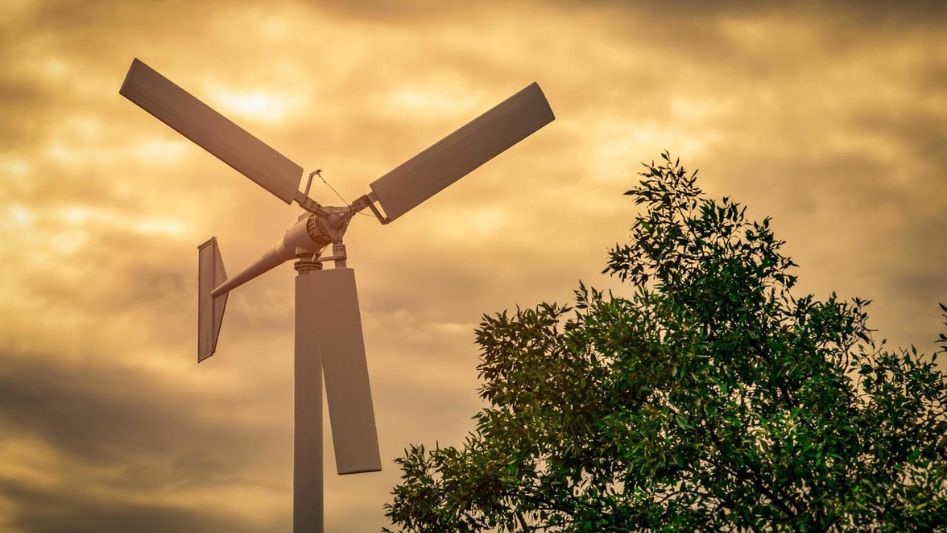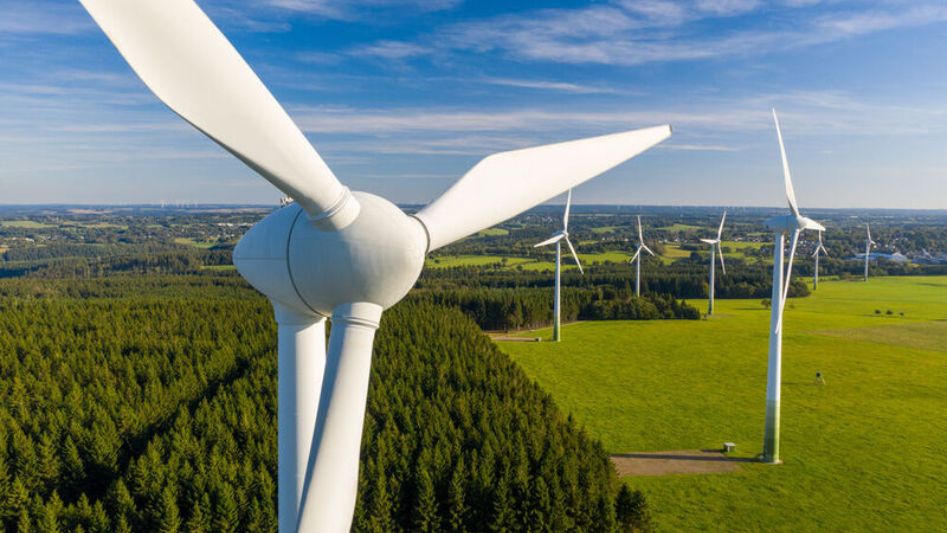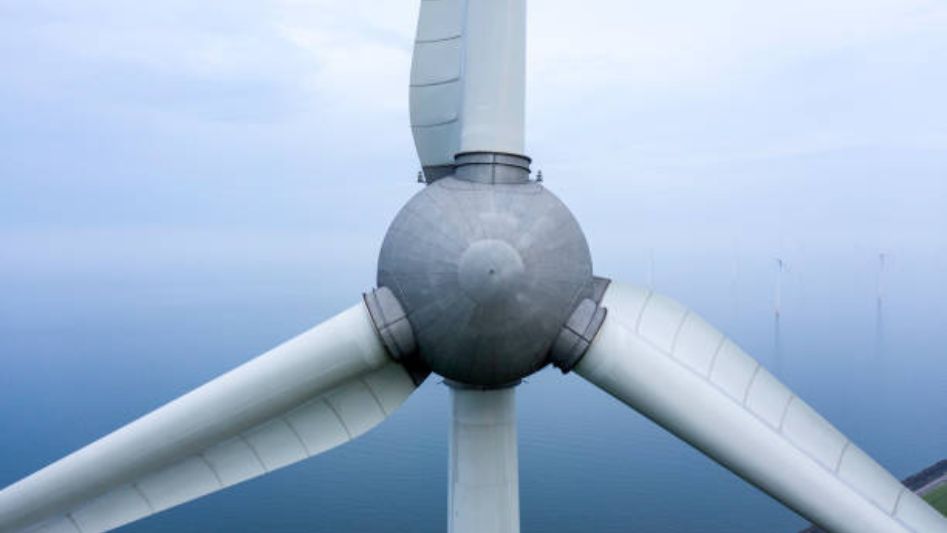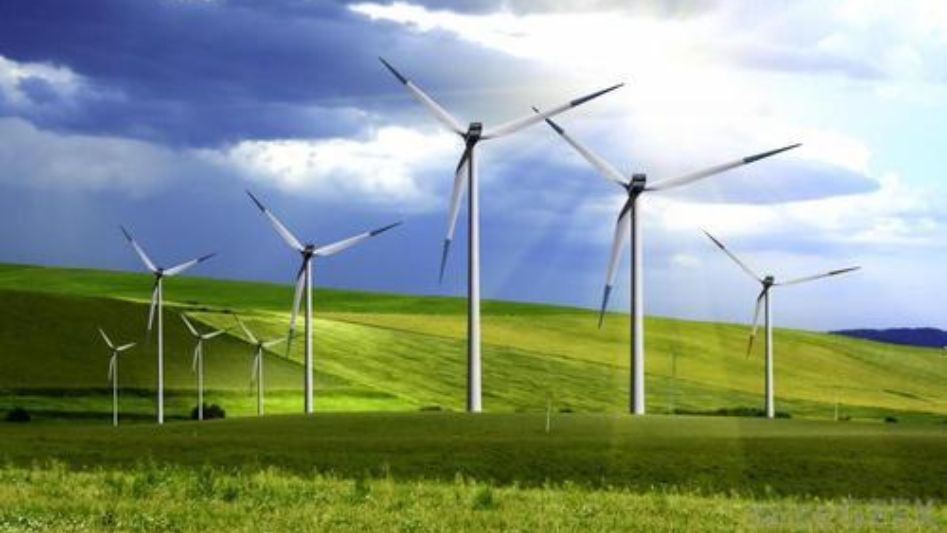A wind turbine is a revolving mechanical device that converts kinetic energy into electrical energy. It does this by changing the direction of the wind. These may be purchased in a variety of sizes, with the axes running either vertically or horizontally. In a wind farm or power plant, the wind turbine is one of the most important pieces of equipment. Therefore, the selection of this turbine for the construction of wind park projects may be done based on a variety of characteristics such as the physical dimensions, nominal power, available area, wind potential, and so on. There are two varieties of wind turbines, which are known as horizontal axis wind turbines and vertical axis wind turbines, respectively. This article provides a general introduction to a wind turbine with a horizontal axis.

What is Horizontal Axis Wind Turbine?
At the moment, the HAWT, which stands for horizontal axis wind turbine, is the kind of wind turbine that is used the most often. These turbines make use of airfoils, which are essentially aerodynamic blades, and link them to a rotor by putting themselves either in the upwind or downwind direction. High-speed operation is standard for them, which may have either two or three rotor blades depending on the model.
Wind turbines with a horizontal axis nowadays make use of the aerodynamic lift force to spin each rotor blade in a manner that is analogous to how an aircraft flies. In most cases, the aerodynamic lift force will begin to function after the segments of a blade that are higher and lower have been exposed to the effects of the wind. A force in the top direction of the blade is generated as a result of the pressure differential that is established between the top and bottom sides of the blade. The line diagram for a wind turbine with a horizontal axis may be seen down below.
Through the usage of the furling mechanism, HAWTs may be employed in whichever direction the wind is blowing. This mechanism spins the face of the rotor such that it is perpendicular to the direction in which the wind is blowing. Therefore, the windward side of the rotor may be turned to face the direction from which it will get the greatest amount of force from the wind.
Horizontal Axis Wind Turbine Construction and Working
Putting together a wind turbine with a horizontal axis may be accomplished using a variety of different parts. Therefore, the foundation, nacelle, generator, tower, and rotor blades make up the majority of the components that make up a horizontal-axis wind turbine.
Wind turbines with a horizontal axis have the rotor shaft and electric generator installed at the very top of the tower. Simple wind vanes are used in smaller wind turbines, while wind sensors are linked to bigger wind turbines through an auxiliary engine in the case of the latter. The majority of wind turbines use a gearbox, the purpose of which is to vary the rotational speed of the blades from a slow to a rapid pace in order to power an electric generator.

Foundation
Because a wind turbine is made up of a number of components, each of which might weigh several tons, the foundation is what provides support for the tower of the wind turbine.
Tower
On the very top of the wind window turbine is a rotor hub and nacelle that need support, and this is provided by a tower. Concrete, tubular steel, or steel lattice may be utilized in the production of this item, depending on the desired look. When it comes to the construction of this wind turbine, the height of the tower is of the utmost significance since the wind speed increases with increasing altitude. Therefore, these turbines are able to catch a significant quantity of energy and generate more power if the towers that house them are higher.
Increasing the height of a wind turbine and reducing the amount of turbulence that it is exposed to may both lead to an increase in the amount of electricity that it generates. Towers for wind turbines come in a variety of shapes and configurations, including tubular, lattice, guyed wind, tilt upwind, and free standing.
Wind Turbine Blades
The primary purpose of these blades is to convert the kinetic energy (KE) of the wind into mechanical energy so that the wind may be harnessed more efficiently. These particular kinds of blades are constructed with wood-epoxy or polyester that has been strengthened with fiberglass. The design of each of these turbines determines the number of blades it has, which might range from one to many.
The vast majority of wind turbines with a horizontal axis each have three blades that are attached to the rotor hub. In days gone by, turbines with multiple blades were employed for a variety of tasks, including grinding, pumping water, and other similar activities. These blade counts ranged from one to three.
Nacelle
The gearbox, brakes, controller, low-speed and high-speed shafts, and generator are all included in the wind turbine’s nacelle, which contains a variety of components necessary for the efficient operation of the wind turbine. A wind vane is positioned above the nacelle, which is positioned atop the tower where it is housed.
Hub
In order to link the shaft to the rotor blades of the wind turbine, a rotor hub is used. A pitch mechanism, blade bearings, bolts, and internals are all included inside the hub. Cast iron, welded sheet steel, and forged steel were used in the construction of these. You may choose between a Hinge-less hub or a Teetering hub when purchasing one of these.
Gear Box
A gearbox is used in wind turbines to convert the high torque power with low speed that is received from a rotor blade into low torque power with high speed. This is done by changing the gear ratio. This energy is used toward running the generator. In order to increase rotational speeds from 30–60 rpm to 1000–1800 rpm, the gearbox is linked in between the generator and the main shaft.
Different kinds of metals and metal alloys, aluminum cast iron, stainless steel, and the like may all be found in the construction of gearboxes. Planetary, helical, and worm gearboxes are the three kinds that are utilized in wind turbines. Worm gearboxes are the most common.
Generator
Through the shaft, the generator is provided with the rotational mechanical energy that is produced by the gearbox. It operates according to the principles outlined in Faraday’s law of electromagnetic induction. Therefore, the energy shifts from being mechanical to being electrical.
Horizontal Axis Wind Turbine Working
A wind turbine is able to convert the kinetic energy that is derived from the velocity of the wind into mechanical energy once the wind begins to blow. This is accomplished by the rotation of the rotor. After that, the energy that has been converted may be sent toward the generator through the shaft and the gear train. In addition, this generator takes the mechanical energy and transforms it into electrical energy in order to produce electricity.
Although the wind blows on both sides of the airfoil-shaped blade, it blows more quickly on the top face of the airfoil, which results in the formation of a low-pressure area on the airfoil. The aerodynamic lift is produced as a consequence of the pressure differential that exists between the top and bottom surfaces.
Lift force generates rotation around the hub of a wind turbine because the blades of the wind turbine are limited to move in a plane with the hub as the center of their movement. In addition to the lift force, another factor that limits rotor rotation is a drag force that is perpendicular to the lift force.
The design of a horizontal axis wind turbine prioritizes having a high lift to drag ratio, particularly for the blades of the turbine. Therefore, this ratio may shift depending on the length of the blades in order to maximize the amount of energy that the wind turbine produces in response to varying wind speeds. Within the box at the very top of the array is where the generator as well as the rotor shaft are located.

Horizontal Axis Wind Turbine Types
There are two distinct varieties of horizontal-axis wind turbines, which include the ones listed below.
- Upwind Turbine
- Downwind Turbine
Upwind Turbine
The rotor of an upwind wind turbine is positioned on the top of the tower rather than the bottom. The primary purpose of this turbine is to eliminate the wind shadow that would otherwise be cast on the rear of the tower. This design is now used in the majority of HAWTs due to the fact that it is non-flexible and is situated some distance away from the tower.
Downwind Turbine
The rotor of a downwind turbine is positioned near the base of the tower rather than at the top. The direction of the wind is first directed toward the tower of this turbine, and then it is directed toward the rotor blades. Due to the fact that the rotor of this wind turbine must pass through the wind shadow of the tower, wind power in general presents this wind turbine with some unique challenges. The fact that the rotor is located in this case behind the nacelle of the tower is the source of variations in wind power.
Advantages and Disadvantages
The following is a list of benefits that come with having a horizontal axis on your wind turbine.
- In comparison to the vertical wind turbine, it has a much higher power output.
- Once there is a change in the wind shear, a tall tower will experience increased winds.
- Excellent productivity.
- When compared to vertical type turbines, the cost of this one is far lower.
- It has a high degree of dependability.
- It has a very high capacity per unit of time.
- High rotating speed characterizes it.
- It is more reliable overall.
- These generators may begin operation on their own.
- The vanes of this turbine are positioned on one face of the turbine’s center of gravity, which contributes to the turbine’s improved stability.
- It is able to bend the blades in order to get the optimal attack angle for the turbine blades.
- During a storm, the blade may also tilt the rotor in order to decrease the amount of damage.
The following is a list of the disadvantages that come with using a horizontal axis wind turbine.
- There is also a huge version of these available.
- The weight is significant.
- We are restricted in our movement.
- The installation process is challenging.
- Extremely loud.
- Large pieces of equipment are required for the design of this wind turbine.
- When compared to other types of wind turbines, it is challenging to maintain this one.
Applications
The following are some of the applications that may make use of wind turbines with a horizontal axis.
- Due to the substantial amount of electricity they generate and the excellent efficiency with which they do so, these wind turbines are the ones that find the most usage in commercial and industrial settings.
- The majority of their applications are in wind farms.
- Horizontal-axis wind turbines are used not only for the production of electricity but also in large-scale wind power plants because of their superior power output as well as their greater energy efficiency.
- The most common places to find these wind turbines are in industrial facilities, large-scale wind farms, and national initiatives. Therefore, they constitute an ideal strategy for the generation of a significant amount of power.
The following organizations may be found on the list of wind turbine manufacturing businesses from across the globe.
- Wind from across the world in India
- Suzlon in India.
- RRB Energy Limited is a company based in India.
- Inox Wind blowing across India.
- Engineering of Electric Circuits in India
- Southwest is a firm based in the United States.
- In the United States, PacWind.
- In China, the China Guodian Corporation
- In the country of China, Shanghai Electric.
- SANY operating in China.
- Goldwind in the Chinese region.
- Imagine the Energy Sector in China.
- CRRC operations in China.
- TUGE Energia Company in Estonia.
- The Guietrevolution Company is located in the United Kingdom.
- Hi-VAWT in Taiwan.
- Enessere is a location in Italy.
- Borny is located in Spain.
- South Korean members of UNISON.
- Senvion was developed in Germany.
- In Germany, Nordex SE is located.
- Enercon’s operations in Germany
- Acciona in Spain.
- NoyaWind is based in Russia.
Which type of wind turbine is most efficient?
When compared to other types of turbines, vertical wind turbines provide a performance boost of up to 15 percent, making them the most efficient kind of turbine.
How many acres do you need for a wind turbine?
In order to prevent interference from other turbines, a wind farm with a capacity of 2 megawatts requires between 40 and 70 acres of land.
Which alternator is best for wind turbines?
A wind turbine utilizes a low-rpm three-phase alternating current alternator, the power output of which may vary anywhere from 50 kW to 1 MW.
Why horizontal axis turbines are preferred over vertical axis wind turbines?
Compared to other types of wind turbines, the horizontal kind may produce more power from the same quantity of wind.
How many amps should an alternator put out at idle?
At 13.5 volts, the alternator is capable of producing 40 amps. When the load is more than 40 amps, the voltage will begin to drop below 13.5 volts and remain there.
In conclusion, the purpose of this article is to provide an overview of the Horizontal axis wind turbine blades, including their construction, operation, kinds, benefits, drawbacks, and applications. In comparison to a single wind turbine, the production volume and efficiency of combined wind turbines, such as horizontal and vertical configurations, would be significantly improved. I have a question for you: what is the difference between a wind turbine with a horizontal axis and one with a vertical axis?

